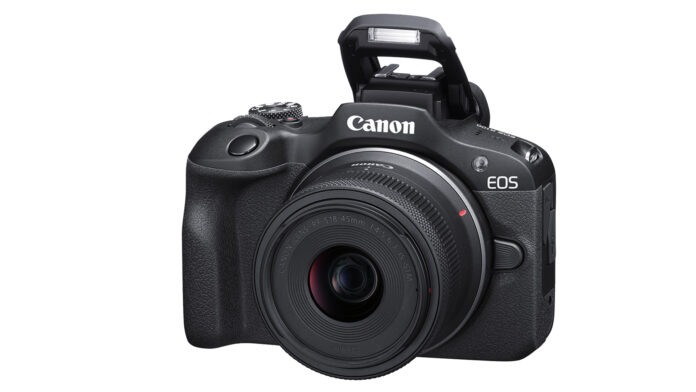Today Canon announced the EOS R100, another entry in its RF-mount mirrorless camera system. The camera is a blunt appeal to entry-level and budget-restricted customers, a segment that’s been left behind by other camera makers. As such, price is one of the R100’s major features, and we won’t bury the lede, it’s priced around $600 with a starter lens, a more competitive figure than you’ll find from other camera makers. For comparison, Sony’s entry-level a6100 is around $850 with a lens.
EOS M50 Mark III?!
To keep costs down, the EOS R100 re-uses an existing imaging platform: the 24MP CMOS sensor and Digic 8 image processor are lifted straight from the EOS M50 Mark II. It’s the same tact Canon takes with its bare-bones EOS T7 SLR, but here the older tech is not so egregiously outdated. The R100’s autofocus supports face- and eye-detection for people, snappy Dual Pixel CMOS focus for stills and 1080p video, and full-width 4K movies with contrast-detect focus.
Leaning on the EOS M50 II platform limits some features—Canon’s newer processor and focus system adds subject recognition for pets, birds, and vehicles, along with Dual Pixel AF for 4K video—giving customers reasons to step up to an EOS R50 or R10, two mid-entry options with fresher sensor and processor tech. But when compared with the Canon EOS T7 SLR, the R100 promises much better performance; the T7 has rudimentary autofocus for stills and manual focus 1080p video.
And while the imaging platform is the same as the M50 Mark II, the R100’s body is very different. It’s smaller, for one, and omits a swing-out LCD, though it does include an eye-level electronic viewfinder. And in a likely effort to attain low pricing, the fixed rear display is just for viewing; it doesn’t have support for touch. It’s a curious decision, especially for a camera that should have some appeal to young creators looking to move up from a smartphone, as well as younger millennials getting a camera to snap pictures of new family arrivals, two target markets Canon called out for this camera. We’re 15-plus years into the iPhone era, it’s now a little weird for a screen not to take touch input.
(Credit: Canon)
Even without touch, Canon is leaning into ease-of-use features for entry-level snappers. The R100 has a full-featured Scene Intelligent Auto mode that strives to recognize the content of a scene and tune processing settings to best capture it. The R100 also supports Program, aperture, shutter, and manual exposure modes. It supports 3.5fps capture with continuous focus, or 6.5fps with focus locked for the sequence. Bluetooth and Wi-Fi are standard on cameras and included, the R100 pairs with Android and iOS devices for on-the-go transfers.
We touched on price—the EOS R100 is available in a kit with the RF-S 18-45mm zoom for $599.99, or in a two-lens kit with the 18-45mm and RF-S 55-210mm for $829.99. You may also get it as a body only for $479.99.
RF System Gets a Pancake Lens
(Credit: Canon)
In addition to the camera, Canon is adding the RF 28mm F2.8 STM lens to its catalog. The lens supports both full-frame models (like the EOS R8) and cameras with APS-C format sensors like the EOS R100.
Full-frame photographers will enjoy an impressively light (4.2-ounce) prime with wide angle coverage, where the 28mm works as a standard prime on APS-C bodies. The lens supports 9.1-inch focus for 1:5.6 macros, includes a 7-blade aperture, and is priced at a reasonable $299. Both the EOS R100 and RF 28mm lens are set to start shipping in July.
Get Our Best Stories!
Sign up for What’s New Now to get our top stories delivered to your inbox every morning.
This newsletter may contain advertising, deals, or affiliate links. Subscribing to a newsletter indicates your consent to our Terms of Use and Privacy Policy. You may unsubscribe from the newsletters at any time.
Visits: 0
















